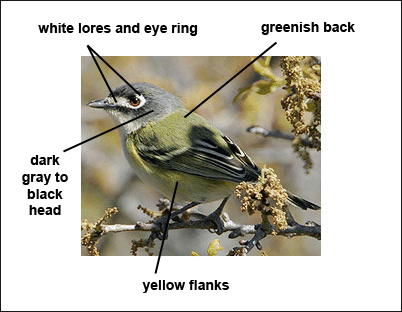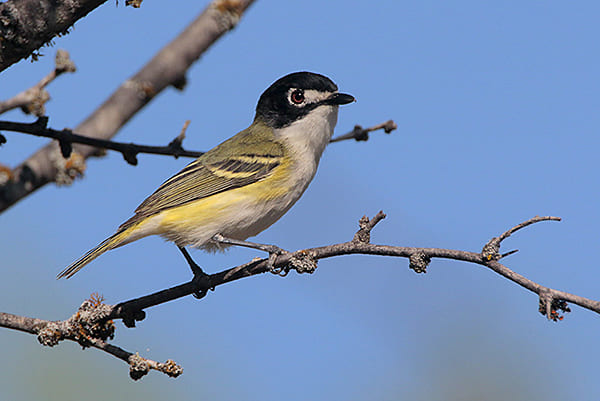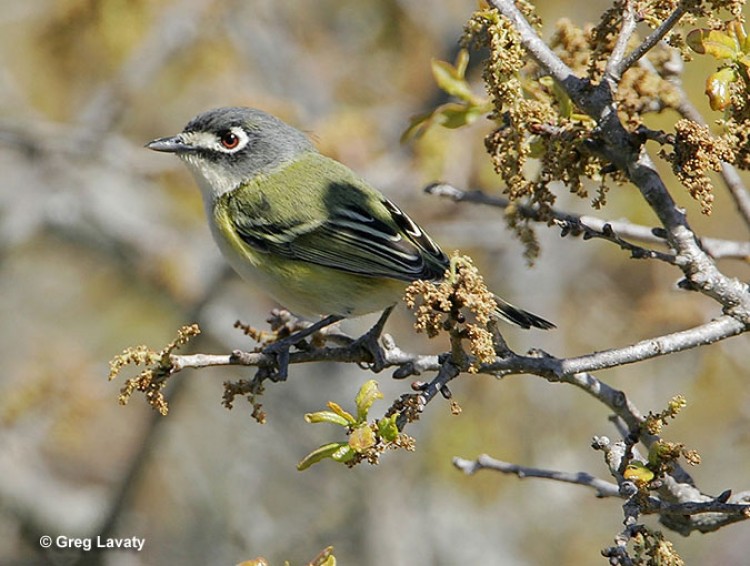An endangered species that is making a comeback, the Black-capped Vireo occupies early successional, scrubby oak habitats in the hot climate of southwestern Oklahoma and Texas. Nest parasitism by Brown-headed Cowbirds has been a significant threat to the small population of Black-capped Vireos, and cowbird trapping is conducted in local areas to increase vireo reproduction.
Young male Black-capped Vireos begin learning to sing at only one to two months of age. During the nesting season, males will sing throughout the day, often from a perch near the top of a tree.
On this page
Description of the Black-capped Vireo
BREEDING MALE
The Black-capped Vireo has greenish upperparts, a gray to black head, bold white spectacles, red eyes, yellowish wing bars, and white underparts. Length: 5 in. Wingspan: 7 in.

Female
The sexes are similar, though females have dark gray heads instead of black.
Seasonal change in appearance
None.
Juvenile
Juveniles are similar to adults but have paler heads.
Habitat
Black-capped Vireos inhabit areas of shrubby deciduous growth, including rocky hillsides.
Diet
Black-capped Vireos eat insects.

Photograph © Greg Lavaty.
Behavior
Black-capped Vireos forage actively in low, dense vegetation.
Range
Black-capped Vireos breed in southwestern Oklahoma, Texas, and Mexico. They winter in Mexico. The Black-capped Vireo is endangered but the population has been increasing in recent years due to habitat management and cowbird control.
More information:
Bent Life History
Visit the Bent Life History for extensive additional information on the Black-capped Vireo.
Fun Facts
The difference in head color between male and female Black-capped Vireos is unique among North American vireos.
Black-capped Vireos have an exceptionally large vocal array.
Vocalizations
Calls include a “zhree” reminiscent of Bewick’s Wren, while the song consists of a fast, complex series of phrases.
Similar Species
Blue-headed Vireo
Blue-headed Vireos have much paler heads but can resemble a female Black-headed Vireo. Ranges overlap in Texas only during migration.
White-eyed Vireo
The White-eyed vireo has much paler head and yellow spectacles.
Nesting
The Black-capped Vireo’s nest is a cup of leaves, weeds, and other plant materials, and is typically placed on a forked twig about 3 feet above the ground.
Number: Usually lay 3-4 eggs.
Color: White.
Incubation and fledging:
The young hatch at about 14-17 days, and begin to fly in about another 2 weeks, though continuing to associate with the adults for some time.
Bent Life History of the Black-capped Vireo
Published by the Smithsonian Institution between the 1920s and the 1950s, the Bent life history series of monographs provide an often colorful description of the birds of North America. Arthur Cleveland Bent was the lead author for the series. The Bent series is a great resource and often includes quotes from early American Ornithologists, including Audubon, Townsend, Wilson, Sutton and many others.
Bent Life History for the Black-capped Vireo – the common name and sub-species reflect the nomenclature in use at the time the description was written.
VIREO ATRICAPILLUS Woodhouse
This well-marked and handsome vireo was discovered by Dr. S. W. Woodhouse while attached to Capt. L. Sitgreaves’s expedition down the Zuni and Colorado Rivers, lie took two specimens, both males, near the source of the Rio San Pedro in western Texas on May 26, 1851. About three years later a third specimen was taken by J. H. Clark, one of the naturalists of the Mexican Boundary Commission, not far from the same locality. Not much more was learned about it until William Brewster (1879) got in touch with Edmund Ricksecker and W. H. Werner, who had acquired three sets of eggs, taken in Comal County, Tex., in 1878. Mr. Werner gave Mr. Brewster considerable information about this, then very rare, vireo. He found them in the northwestern part of Comal County, along the Guadaloupe River. “They were not very plenty; I noticed during my rambles ten to twelve specimens in a radius of about ten miles, in the course of six weeks. The peculiar song of the male first attracted my attention, and as soon as I saw the bird I was sure that it belonged to the Vireo genus. They seemed to prefer mountainous districts; at least I always found them in such localities. They frequented low brushwood, and built their nests from three to four feet above the ground.”
Since then, much has been learned about the distribution and habits of the black-capped vireo. It is now known to breed from southwestern Kansas, southward through Oklahoma and southwestern Texas, and to winter in Mexico at least as far south as Sinaloa.
In Kansas, Col. N. S. Goss (1891) found them quite common in summer in the deep ravines in the gypsum hills. “These birds are very local in their distribution, and, until of late, very little has been known in regard to their habits. They inhabit the oak woods upon the uplands, and the bushes and trees in the ravines on bluffy prairie lands.”
C. D. Bunker (1910) describes somewhat similar nesting haunts in Blame County, Okla.: “In the locality of which I speak, the canyons were about three hundred and twenty feet deep, with outcroppings of gypsum rock from bottom to top, with a strong salt stream running at the bottom. The only fresh water for miles was a spring on the ridge, a quarter of a mile above the head of the canyon. The canyon walls, and gulches leading to the canyons, were studded with clumps of bushes, mostly dog-wood, scrub-oak and similar shrubs forming ideal cover for vireos, of which Vireo belli was not uncommon. On one occasion a nest of a Bell’s Vireo was found in the same bush with that of a Black cap.
George F. Simmons (1925) says that its haunts in central Texas are “typically, scrub-oak ridges, ravines, and canyons. Hottest imaginable places on sterile ridges or backbones among peaks of the small mountains or limestone hills of central Texas, among clumps of scrub oak, cedar, broad-leaved deciduous bushes, and chaparral brush, scantily scattered among small mountain live oaks and shaded mountain Spanish oak thickets on steep, sterile, rocky slopes of peaks which break in endless strata down to the valleys below; scrub oak thickets; oak thickets along bottoms of dry ravines; vine-grown thickets on canyon walls.”
Nesting: We are indebted to Mr. Brewster (1879) for the first published account of the nesting habits of this vireo, in which he says that “to Mr. Werner is due all credit for discovering the first authentic nest of the Black-capped Vireo known to science. Those received by Mr. Ricksecker were collected May 26 and June 13 respectively.” That was in 1878, in Comal County, Tex. The former came to Mr. Brewster and was said to have been built in a “red-oak tree.” Mr. Brewster describes it.as follows: “It is suspended in the fork of two very slender twig~, a~nd is in every way after the usual type of Vireonine architecture. In a few points of detail, however, it differs slightly from any Virco’s n~st that I have seen. Although, generally speaking, of the ordinary cup-shaped form, the walls are unusually thick and firmly felted, and the entrance being very much contracted, the bulging sides arch over the mouth of the nest., giving to the whole a nearly spherical shape.”
After confessing his lack of knowledge of Texas botany, he writes:
The great bulk of the structure, however, is made up of fine strips of reddish bark, probably from some species of cedar, layers of small, delicate, bleached leaves of a former year’s growth, a few coarse grasses, one or two catkins, and several spiders’ cocoons. These are firmly bound together, and the whole attached to the forked twigs above by fine shreds of vegetable fibre, caterpillars’ or spiders’ silk, and sheep’s wool. The lining Is of fine grasses and what appear to be the slender needles of some coniferous tree, the whole being arranged with that wonderful smoothness and care which belong to the highest order of nestbuilders alone. * * ~ Greatest external diameter, 2.90; external depth, 2.25; internal diameter at mouth, 1.30 x 1.68; internal depth, 1.40; greatest thickness of walls, .63.
Of the measurements of the other nest, he says: “The greatest diameter is 8 inches; inside diameter, 1.75 inch; depth, 1.80 inch; thickness of walls, from .45 to .60 of an inch.”
Mr. Simmons (1925) says of the nest location in central Texas: “2 to 6, rarely 15, usually 4, feet from the ground, suspended from horizontal forked twig of small scrub oak, live oak, Spanish oak, or elm bush or stunted tree, usually among low shin oaks and elms and dwarf plum thickets on dry hillsides near a stream, a habitat never frequented by the White-eyed Vireo; in tangled thickets of dewberry; in low trees on edge of thick mountain shrubbery; less commonly, in deep shady ravines where the White-eyed Virco places its nests.”
Mr. Bunker (1910) says of the nests found in Blame County, Okla.:
The nesting habits of the Black-cap are unlike Bell’s, In that it always builds in the center of a bush or rather In a clump of bushes instead of on the outer edge, slips away upon the approach of an intruder, and if singing or scolding in a bush, you may depend upon it, that the nest is nowhere near. * * * Nests were found at the bottom of canyons, and steep canyon walls, uplands, and little draws leading to the canyons. They nested in jack-oak, dogwood, wild plum, China berry and like shrubs. No matter where the nest was bunt, on bottom lands, or ravines, the bush in which it was placed was always above high water mark. * * * I was fortunate enough to watch the construction of one nest from start to finish. The weaving was accomplisht after the fibers bad all been attacht to the forked twig, and hung down like a fringe. The female would dart down from a nearby twig, catch the end of a fiber in her hill, fly up to the opposite side of the fork, draw up the fiber a little at a time, turning her head from side to side, as if studying her work, and then secure It.
Eggs of the eastern, and more often those of the dwarf, cowbird are sometimes found in the nests of this virco.
Eggs: Three to five eggs may make up the full set for the blackcapped virco, but four seems to be the commonest number. These are ordinarily ovate in shape, but some are slightly pointed and others are somewhat elongated. The shell is smooth, without gloss, pure white in color and always (?) entirely spotless. The measurements of 50 eggs averaged 17.6 by 13.1 millimeters; the eggs showing the four extremes measure 19.3 by 12.7, 18.8 by 14.7, 16.0 by 12.7, and 16.7 by 12.2 millimeters.
Incubation: The period of incubation does not seem to have been determined. Both sexes assist in the duties of incubation and usually stick so closely to the nest that they can almost be touched. Nothing seems to have been published on the development and care of the young, but probably both parents do their shares of this work. Mr. Simmons (1925) says that “usually one, rarely two, broods” are raised in a season.
Plumages: Mr. Ridgway (1904) says that the juvenal plumage is similar to that of the adult, “but without black or clear gray on head, which is replaced by grayish brown or brownish gray; olivegreen of back, etc., browner; white of under parts and head markings much less pure, strongly washed with pale buff or brownish buff, the sides and flanks more brownish olive-green.”
The sexes are alike in the juvenal plumage, but quite different after the postjuvenal molt. For many years it was thought that the sexes were alike in all plumages, as they are in most of the vireos, but now it seems to be well-established that the black head markings of the male are replaced by slate-gray in the female; the wing bars and light edgings of the tertials are yellow in the male and whitish in the female; the olive-green of the back is duller in the female and the white of the underparts and head is less pure than in the male. The iris in both sexes is said to be light brick red: Van Tyne and Sutton (1937) call it “a striking shade of light, clear, reddish brown: this shade in sharp contrast to the whiteness of the eye ring and blackness of the cap.”
I have seen no molting birds.
Food: There seems to have been no comprehensive study made of the food of the black-capped vireo. Mr. Simmons (1925) makes the brief statement that it “feeds low among the dwarf shin oak and scrub oak or dwarf plum thickets on ridges and dry hillsides, searching for caterpillars, other insects, and their eggs.”
Behavior: Mr. Simmons (1925) says that it is “observed singly or in pairs. Very shy and quick, dodging in and out among thick foliage of bushes, and from one dense clump to another; alert, active, and energetic, hopping and flying briskly about, generally keeping close to cover of bushes.”
Evidently the quiet demeanor and deliberate, leisurely movement, so characteristic of most vireos, are quite lacking in the blackeap, for all observers seem to agree on its restless activity. Some say that it can be easily approached to within a reasonable distance and is really not very shy, but that its constant hopping and flitting about in the thick foliage make it a difficult bird to collect. Several have mentioned being able to almost touch it on the nest when incubating. Van Tyne and Sutton (1937) observed that “the birds were given to dropping from one perch to a lower perch, letting their bodies swing downward while still holding tightly with their feet, then suddenly letting ~ Voice: The black-capped vireo must be a very striking and quite versatile singer, but one easily recognized when the form of its song is once learned. Mrs. Nice (1931) listened to one singing in Oklahoma, of which she writes:
He sang continuously, giving an extraordinary variety of phrases, all of them harsh, vehement and unnausical. One phrase (tee war twit) reminded me of a Chewink In Its timing and pitch, others of a Chat. The number of phrases given per minute was 31, 31, 29, 28, 32. A different bird gave 29 in one minute. Intervals between beginnings of phrases varied from 1.8 to 3 seconds. No phrase was given more than once at one time. I was not able to record all of his expressions, but the following are samples: hee-hee ch(sr, Itee pr&, chee-chee-checchee, hee-hee-hee, whit whit whit, sissiwit bed, hai, party, tar vera chde, wheep, hur wee chde.
The phrases of another bird across the creek were all somewhat different from those of the first bird. Some that I recorded are: which er chde (a Chewink-like note), dee dee dee, what kde, whip chdr.~whip )cde.
Mr. Simmons (1925) calls the song, “varied, reminiscent of that of the White-eyed Vireo, but less emphatic and more of a gentle warble; somewhat like the song of the Bell Vireo, but much slower and more distinct, less of a helter-skelter roundelay; a subdued, low, sweet, persistent musical warble, neither hurried nor slow, as though the bird were making insistent efforts to pronounce its name ï * * * also interpreted as a loud, emphatic, liquid there now, wait-a-bit or come here, right-now-quick. First and second usually alternate at regular intervals; first and sixth end with a peculiar, fine, tinkling, bell-like quality which is very attractive. * * * Sings from arrival in March until mid-August, frequently from the nest after the manner of the Bell Vireo. A hoarse alarm note.”
William Lloyd (1887) says that “the~song is loud, clear, and very musical, and the singer generally selects some blasted pecan stump for the site of his vocal efforts. The female has also a song, sweet, but not particularly noticeable.”
Field marks: The conspicuous black and white head pattern of the male is diagnostic and that of the female is only duller in color. No other vireo even approaches this, and there is no other bird within ~ts habitat for which the black-capped virco might be mistaken.
DISTRIBUTION
Range: Southern Kansas to central Mexico.
Breeding range: The breeding range of the black-capped virco seems to be very restricted. Nests have been found north to central southern Kansas (Comanche County, one record) ; north-central Oklahoma (Stillwater and Tulsa). East to east-central Oklahoma (Tulsa and Spencer) ; and central Texas (Dallas, Waco, Austin, New Braunfels, and Castroville). South to south-central and southwestern Texas (Castroville, Medina, High Bridge, Langley, and the Chisos Mountains): It seems probable that it breeds also in northern Coahuila, but at present no data are available. West to southwestern Texas (Chisos Mountains, Glass Mountains, and San Angelo) ; southwestern Oklahoma (Wichita Mountains Wildlife Refuge); and central southern Kansas (Comanche County).
Winter range: So far as is known the black-headed vireo in winter is confined to the southern half of Sinaloa. Specimens from Vo1c~n Toluca, Mexico, on September 11, and Santa Leonor, Tamaulipas, on April 12, were probably migrant individuals.
Migration: Few records are available. The dates of occurrence in Sinaloa are from September 22 to March 20. In Texas they have arrived at Kerrville by March 19 and have been seen at San Angelo to September 25.
Casual records: The black-capped vireo has been taken in eastern Nebraska twice; near Bellevue, on June 19, 1894, and at Meadow, on May 19, 1921. Both localities are just south of Omaha.
Egg dates: Oklahoma: 7 records, May 20 to July 20.
Texas: 26 records, April 17 to June 23; 13 records, May 15 to Jane 3, indicating the height of the season.


